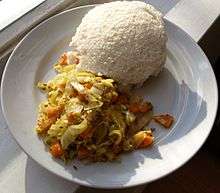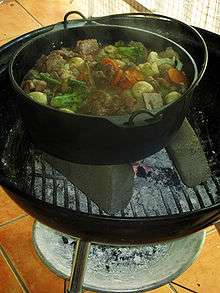African cuisine
Traditionally, the various cuisines of Africa use a combination of locally available fruits such as, cereal grains and vegetables, as well as milk and meat products,[1][2] and do not usually have food imported. In some parts of the continent, the traditional diet features an abundance of milk, curd and whey products.[3][4]
Central Africa, East Africa, North Africa, Southern Africa and West Africa each have distinctive dishes, preparation techniques, and consumption mores.[1][5]
Central Africa
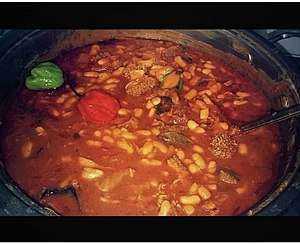
Central Africa stretches from the Tibesti Mountains in the north to the vast rainforest basin of the Congo River, the highlands of Kivu and the savana of Katanga. This region has received culinary influence of the Swahilis (a culture that evolved via the combination of Bantu, Yemeni, Omani and Indian cultures) during the East African Slave Trade. Swahili culinary influences can be found in dishes such as: mandanzi, pilaf rice, kachumbari, sambsusa, kuku paka, etc.[6] Central African cuisine has also been influenced by the Portuguese, by way of the Kongo and Ndongo Kingdoms. Salt fish was introduced following trade in the late XVIIth and the Kikongo term for salt fish, makayabu, comes from the term bacalhau (ba-cal-ha-u).[7] The Portuguese culinary influence is especially prominent in Angola, Sao Tomé and Equatorial Guinea. Central Africa has also been influenced by the cuisine of the regions East, West and Southern Africa because of their close proximity. I.e: Babuté/Bobotie is shared with the south, nyama choma with the east and gombos with West Africa.

The main ingredients are plantains, cassava, rice, kwanga (cassava dumpling) and yam. Fufu-like starchy foods are usually made from fermented cassava roots, but they can also be made with plantain, corn maize and yam. Fufu is served buffet style with grilled meat, fish, stews, greens and piment . A variety of local ingredients are used while preparing other dishes like spinach stew cooked with tomato, peppers, chillis, onions, and peanut butter.[8] Eastern central Africa is also one of the few regions in Africa that uses potatoes as one of its main bases, since potatoes grow easily in the region.
Cassava plants are also consumed as cooked greens. Groundnut (peanut) stew is also prepared, containing chicken, okra, ginger, and other spices. Another commonly served dish is bambara, a porridge of rice, peanut butter and sugar. Chicken and fish are favorite meat dishes, but game meat preparations containing crocodile, elephant, antelope and warthog are also served occasionally.[9][10][11][12][13]
East Africa


The cuisine of East Africa varies from area to area. In the inland savannah, the traditional cuisine of cattle-keeping peoples is distinctive in that meat products are generally absent. Cattle, sheep, pigs and goats were regarded as a form of currency[14] and a store of wealth, and are not generally consumed as food.
In some areas, traditional East Africans consume the milk and blood of cattle, but rarely the meat. Elsewhere, other peoples are farmers who grow a variety of grains and vegetables. Maize (corn) is the basis of ugali, the local version of West and Central Africa's fufu. Ugali is a starch dish eaten with meats or stews. In Uganda, steamed green bananas called matoke provide the starch filler of many meals.
Around 1000 years ago, Omani and Yemeni merchants settled on the Swahili Coast. Middle Eastern influences are especially reflected in the Swahili cuisine of the coast – steamed or cooked rice with spices in Persian style; saffron, cloves, cinnamon and several other spices; and pomegranate juice.[15]
Several centuries later, the British and the Indians came, and both brought with them foods such as Indian spiced vegetable curries, lentil soups, chapattis and a variety of pickles which have influenced various local dishes. Some common ingredients used in this region include oranges, lemons, limes, chillis, capsicum peppers, maize, tomatoes, and strawberries.
In the Horn of Africa, the main traditional dishes in Eritrean cuisine and Ethiopian cuisine are tsebhis (stews) served with injera[2][16] (flatbread made from teff,[16] wheat, or sorghum) and hilbet (paste made from legumes, mainly lentils and fava beans). Eritrean and Ethiopian cuisine (especially in the northern half) are very similar, given the shared history of the two countries.
Eritrean and Ethiopian food habits vary regionally. In the highlands, injera is the staple diet and is eaten daily among the Tigrinya. Injera is made out of teff, wheat, barley, sorghum or corn, and resembles a spongy, slightly sour pancake. When eating, diners generally share food from a large tray placed in the center of a low dining table. Numerous injera is layered on this tray and topped with various spicy stews. Diners then break into the section of injera in front of them, tearing off pieces and dipping them into the stews.
In the lowlands, the main dish is akelet, a porridge-like dish made from wheat flour dough. A ladle is used to scoop out the top, which is filled with berbere and butter sauce and surrounded by milk or yoghurt. A small piece of dough is broken and then used to scoop up the sauce.
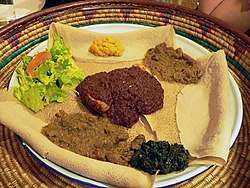
The best known Ethio-Eritrean cuisine consists of various vegetable or meat side dishes and entrées, usually a wat, or thick stew, served atop injera, a large sourdough flatbread made of teff flour. One does not eat with utensils, but instead uses injera to scoop up the entrées and side dishes.
Tihlo, prepared from roasted barley flour, is very popular in Amhara, Agame, and Awlaelo (Tigray). Traditional Ethiopian cuisine employs no pork or shellfish of any kind, as they are forbidden in the Jewish and Ethiopian Orthodox Christian faiths. It is also very common to eat from the same dish in the center of the table with a group of people.
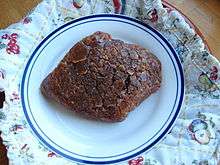
Somali cuisine varies from region to region and consists of an exotic mixture of diverse culinary influences. It is the product of Somalia's rich tradition of trade and commerce. Despite the variety, there remains one thing that unites the various regional cuisines: all food is served halal. There are therefore no pork dishes, alcohol is not served, nothing that died on its own is eaten, and no blood is incorporated. Qaddo or lunch is often elaborate.
Varieties of bariis (rice), the most popular probably being basmati, usually serve as the main dish. Spices like cumin, cardamom, cloves, cinnamon and sage are used to aromatize these different rice dishes. Somalis serve dinner as late as 9 pm. During Ramadan, dinner is often served after Tarawih prayers, sometimes as late as 11 pm.
Xalwo (halwo) or halva is a popular confection served during special occasions such as Eid celebrations or wedding receptions. It is made from sugar, cornstarch, cardamom powder, nutmeg powder, and ghee. Peanuts are also sometimes added to enhance texture and flavor.[17] After meals, homes are traditionally perfumed using frankincense (lubaan) or incense (cuunsi), which is prepared inside an incense burner referred to as a dabqaad.
North Africa
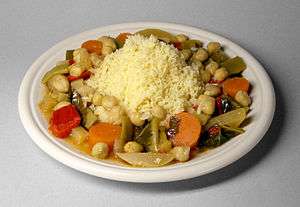
North Africa lies along the Mediterranean Sea and encompasses within its fold several nations, including Morocco, Algeria, Libya, Tunisia, Egypt and Sudan. The roots of North African cuisine can be traced back to the ancient empires of North Africa, particularly in Egypt, where many of the country's dishes and culinary traditions date back to African antiquity.
Over several centuries traders, travelers, invaders, migrants and immigrants all have influenced the cuisine of North Africa. The Phoenicians of the 1st century brought sausages, while the Carthaginians introduced wheat and its by-product, semolina. The Berbers adapted semolina into couscous, one of the main staple foods. Olives and olive oil were introduced before the arrival of the Romans.
From the 7th century onwards, the Arabs introduced a variety of spices, like saffron, nutmeg, cinnamon, ginger and cloves, which contributed and influenced the culinary culture of North Africa. The Ottoman Turks brought sweet pastries and other bakery products, and from the New World, North Africa got potatoes, tomatoes, zucchini and chili peppers.
Most of the North African countries have several similar dishes, sometimes almost the same dish with a different name (the Moroccan tangia and the Tunisian coucha are both essentially the same dish, a meat stew prepared in an urn and cooked overnight in a public oven), sometimes with a slight change in ingredients and cooking style. To add to the confusion, two completely different dishes may also share the same name (for example, a "tajine" dish is a slow-cooked stew in Morocco, whereas the Tunisian "tajine" is a baked omelette/quiche-like dish). There are noticeable differences between the cooking styles of different nations, from the sophisticated, full-bodied flavors of Moroccan palace cookery to the fiery dishes of Tunisian cuisine and the humbler, simpler cuisines of Egypt and Algeria.[18]
Southern Africa
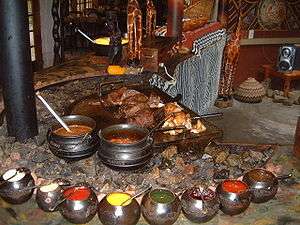
The cooking of Southern Africa is sometimes called "rainbow cuisine",[19] as the food in this region is a blend of many cultures: indigenous African societies, European, and Asian. To understand indigenous African cuisine, it is important to understand the various native peoples of southern Africa. The indigenous Africans of Southern Africa were roughly divided into two groups and several subgroups.
The largest group consisted of the Bantu-speakers, whose descendants today may identify themselves by various subgroup names such as Ndebele, Shona, Venda, Zulu, Xhosa, Swazi, Sotho, Tswana, Pedi, Shangaan and Tsonga. They arrived in the region around 2,000 years ago, bringing crop cultivation, animal husbandry, and iron toolmaking with them. Hence the Bantu-speakers grew grain crops extensively and raised cattle, sheep and goats. They also grew and continue to grow pumpkins, beans, and leafy greens as vegetables.
A smaller group were the primeval residents of the region, the Khoisan, who some archaeologists believe had lived in the region for at least 10,000 years. Many descendants of the Khoisan people have now been incorporated into the population of South Africa. The Khoisan originally were hunter-gatherers (who came to be known as "San" by the Bantu-speakers and as "bushmen" by Europeans). After the arrival of the Bantu-speakers, however, some Khoisan adopted the Bantu-speakers' raising of cattle but did not grow crops. The Khoisan who raised cattle called themselves "Khoi-Khoi" and came to be known by Europeans as "Hottentots."
People were, in other words, defined to some extent by the kinds of food they ate. The Bantu-speakers ate dishes of grain, meat, milk and vegetables, as well as fermented grain and fermented milk products, while the Khoi-Khoi ate meat and milk, and the San hunted wild animals and gathered wild tubers and vegetables. In many ways, the daily food of native South African families can be traced to the indigenous foods that their native African ancestors ate. The Khoisan ate roasted meat, and they also dried meat for later use.
The influence of their diet is reflected in the universal Southern African love of barbecue (generally called in South Africa by its Afrikaans name, a "braai") and biltong (dried preserved meat). The traditional beer was ubiquitous in the southern African diet, and the fermentation added additional nutrients to the diet. It was a traditional obligation for any family to be able to offer a visitor copious amounts of beer. Beer brewing was done by women, and the status of a housewife in pre-colonial southern Africa depended significantly on her skill at brewing delicious beer.
Milk was historically one of the most important components of the southern African diet. Cattle were considered a man's most important possession, and in order to marry, a man had to compensate his prospective in-laws with a gift of cattle as a dowry for his bride. A married man was expected to provide a generous supply of milk to his wife and children, along with meat whenever he slaughtered cattle, sheep or goats. Because there was no refrigeration, most milks was soured into a kind of yogurt.
The young men of the family often took care of the cattle far away from the villages at "cattle posts," and they sent a steady stream of yogurt home on behalf of their fathers. Today, many Black South Africans enjoy drinking sour milk products that are sold in the supermarket, comparable to American buttermilk, yogurt, and sour cream. On weekends they, like white South Africans, will have a "braai", and the meal usually consists of "pap and vleis", which is maize porridge and grilled meat.
The basic ingredients include seafood, meat products (including wild game), poultry, as well as grains, fresh fruits and vegetables. Fruits include apples, grapes, mangoes, bananas and papayas, avocado, oranges, peaches and apricots. Desserts may simply be fruit, but there are some more western-style puddings, such as Malva Pudding reminiscent of Sticky toffee pudding, which was inspired by both British cuisine and Dutch cuisine. Meat products include lamb, and game like venison, ostrich, and impala. The seafood includes crayfish, prawns, tuna, mussels, oysters, calamari, mackerel, and lobster. There are also several types of traditional and modern alcoholic beverages including many European-style beers.
Countries
- Botswana cuisine
- Cuisine of Eswatini
- Cuisine of Lesotho
- Namibian cuisine
- South African cuisine
- Mozambican cuisine
West Africa
A typical West African meal is made with starchy items and can contain meat, fish as well as various spices and herbs. A wide array of staples are eaten across the region, including fufu, banku, kenkey (originating from Ghana), foutou, couscous, tô, and garri, which are served alongside soups and stews. Fufu is often made from starchy root vegetables such as yams, cocoyams, or cassava, but also from cereal grains like millet, sorghum or plantains.
The staple grain or starch varies between regions and ethnic groups, although corn has gained significant ground as it is cheap, swells to greater volumes and creates a beautiful white final product that is greatly desired. Banku and kenkey are maize dough staples, and gari is made from dried grated cassavas. Rice dishes are also widely eaten in the region, especially in the dry Sahel belt inland. Examples of these include benachin from The Gambia and Jollof rice, a pan-West African rice dish similar to Arab kabsah.
Seeds of Guinea pepper (Aframomum melegueta; also called grains of paradise or melagueta pepper), a native West African plant, were used as a spice and even reached Europe, through North African middlemen, during the Middle Ages. Centuries before the influence of Europeans, West Africans were trading with the Arab world and spices like cinnamon, cloves, and mint were not unknown and became part of the local flavorings. Centuries later, the Portuguese, French and British influenced the regional cuisines, but only to a limited extent.

The local cuisine and recipes of West Africa continue to remain deeply entrenched in the local customs and traditions, with ingredients like native rice (Oryza glaberrima), rice, fonio, millet, sorghum, Bambara groundnuts and Hausa groundnuts, black-eyed peas, brown beans, and root vegetables such as yams, cocoyams, sweet potatoes, and cassava. Cooking techniques include roasting, baking, boiling, frying, mashing, and spicing. A range of sweets and savories are also prepared.
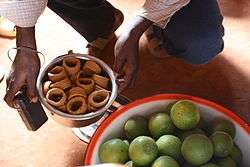
Cooking techniques of West Africa are changing. In the past West Africans ate much less meat and used native oils (palm oil on the coast and shea butter in Sahelian regions). Baobob leaf and numerous local greens were everyday staples during certain times of the year. Today the diet is much heavier in meats, salt, and fats. Many dishes combine fish and meat, including dried and fermented fish. Flaked and dried fish is often fried in oil, and sometimes cooked in sauce made up with hot peppers, onions, tomatoes, and various spices (such as soumbala) and water to prepare a highly flavored stew.
In some areas beef and mutton are preferred, and goat meat is the dominant red meat. Suya, a popular grilled spicy meat kebab flavored with peanuts and other spices, is sold by street vendors as a snack or evening meal and is typically made with beef or chicken. It is common to have a preponderance of seafood and the seafood, as earlier stated, is sometimes also mixed with other meat products. Guinea fowl eggs, eggs and chicken are also preferred.
With regard to beverages, water has a very strong ritual significance in many West African nations (particularly in dry areas) and water is often the first thing an African host will offer his/her guest. Palm wine is also a common beverage made from the fermented sap of various types of palm trees and is usually sold in sweet (less-fermented, retaining more of the sap's sugar) or sour (fermented longer, making it stronger and less sweet) varieties. Millet beer is another common beverage.
Countries
- Benin cuisine
- Burkinabé cuisine, Burkina Faso
- Gambian cuisine
- Ghanaian cuisine
- Cuisine of Guinea-Bissau
- Cuisine of Guinea
- Ivorian cuisine
- Liberian cuisine
- Malian cuisine
- Mauritanian cuisine
- Nigerian cuisine
- Cuisine of Niger
- Cuisine of Saint Helena
- Senegalese cuisine
- Cuisine of Sierra Leone
- Togolese cuisine
See also
- AfroFoodtv.com
- List of African dishes
- Cuisine of Seychelles
- Tiep
References
- School Foodservice Journal. American School Food Service Association. 1977. p. 36. Retrieved 2017-11-30.
- Neo-Africanism: The New Ideology for a New Africa. Trafford Publishing. 2008. p. 505. ISBN 978-1-4251-7678-5. Retrieved November 30, 2017.
- "Food". African Fest USA. Retrieved 2020-05-24.
- "Food Alive and Well". Carifika Canada. Retrieved 2020-05-27.
- Njogu, K.; Ngeta, K.; Wanjau, M. (2010). Ethnic Diversity in Eastern Africa: Opportunities and Challenges. Twaweza Communications. pp. 78–79. ISBN 978-9966-7244-8-9. Retrieved 2017-11-30.
- Coquery-Vidrovitch, Catherine; Mésnard, Éric (2013). L’esclavage intégré en Afrique (fin du xviiie-xixe siècle). Cahiers Libres.
- Thronton, John (1981). "Early Kongo-Portuguese Relations: A New Interpretation". History in Africa. VIII (I): 22.
- Newton, A. (1994). Central Africa: a travel survival kit. Lonely Planet travel survival kit. Lonely Planet. p. 77. ISBN 978-0-86442-138-8. Retrieved November 30, 2017.
- Huchzermeyer, F.W. (2003). Crocodiles: Biology, Husbandry and Diseases. CABI. p. 130. ISBN 978-0-85199-798-8. Retrieved November 30, 2017.
- Elephant meat trade in Central Africa : Republic of Congo case study. Iucn. p. 36. ISBN 978-2-8317-1419-6. Retrieved November 30, 2017.
- Stiles, D. (2011). Elephant Meat Trade in Central Africa: Summary Report. IUCN. p. 25. ISBN 978-2-8317-1393-9. Retrieved November 30, 2017.
- Whitford, J. (1877). Trading Life in Western and Central Africa. "Porcupine" Office. p. 212. Retrieved November 30, 2017.
- Gibbons, A.S.H. (1898). Exploration and Hunting in Central Africa 1895-96. Methuen & Company. p. 223. Retrieved November 30, 2017.
- "'A cow is as good as a man - or better.' African Initiatives in Tanzania". The Big Issue. August 7, 2017. Retrieved November 30, 2017.
- "Africa". Issuu. Retrieved 2020-05-27.
- "Eritrean Food Practices." Webcitation.org. Accessed July 2011.
- Barlin Ali, Somali Cuisine, (AuthorHouse: 2007), p.79
- Wolfert, Paula. "The Dishes of North Africa". National Association for the Specialty Food Trade, Inc. Archived from the original on 2007-10-21.
- Osseo-Asare, F. (2005). Food Culture in Sub-Saharan Africa. Food culture around the world. Greenwood Press. p. 59. ISBN 978-0-313-32488-8. Retrieved August 13, 2017.
Further reading
- McCann, James C. (2009). Stirring the Pot: A History of African Cuisine. Athens, Ohio: Ohio University Press. ISBN 9780896802728. Retrieved 30 October 2016.
